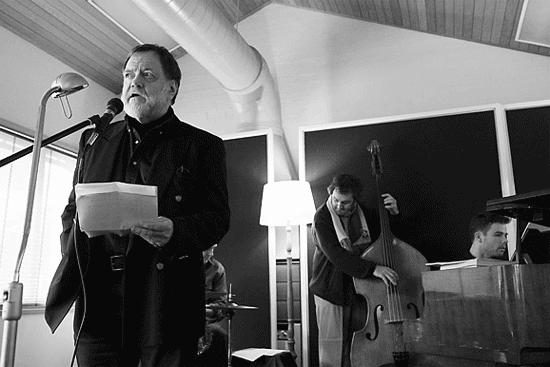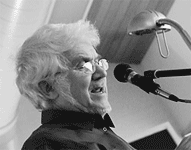In the work I (and sometimes fellow poet, Lynn Hard) have done so far with musicians including Bernie McGann, Carl Dewhurst, Eric Ajaye, Jonathan Zwartz, Alex Boneham, Damien Slingsby, Jarrah Jones, Luke Sweeting, Simon Milman and Mark Sutton, I have tended to strike a different balance. In a performance Lynn and I gave with the Luke Sweeting Trio (piano, bass, drums) at The Loft in Canberra in June this year we viewed the music as a support and an intensifier to the poetry rather than the poetry’s being an addendum (or introduction) to the music. Several of Lynn’s poems were written as responses to well-known jazz standards such as ‘Whisper Not’ and ‘Milestones’ and began with a complete chorus of the tune played first by the trio, followed by the poem which was timed to take up one or two choruses. On this occasion all of our poems were about jazz in one way or another – though I have performed with jazz musicians (eg. Eric Ajaye on bass) some of my poems on other themes with, I hope, equal effectiveness.

Lynn Hard with Simon Milman at The Loft in Canberra, 17 June, 2012
Chet Baker and Me The fingers pressed the valves of the horn Like the long ringing of a door bell And The sound from the trumpet Rushed past me like another weather. Even now, 30 years after, It’s always a cloudless blue day at the beach When I hear Chet Baker play; The sun rippling like water On the hoods and trunks of the ’55 Chevy’s, The chrome fences of bumper Too bright to bear. We all wanted to be Chet Baker The looks, the voice, The detachment that was attached, Living a life without vibrato. We copied him As if this unlettered lesson could be learned. Eventually we all learned other lessons And Chet was left with his finger on the bell. In Amsterdam, A life of back against the wall Ended When the wall was a window. The last flight was a fall To lie on the film strip of the sidewalk For careful citizens of the Netherlands To pick their way past. The beach at Hermosa, The sand dinted with footprints, Is empty; The sky a hardtop blue, scratched with contrails; The waves skid in Showing white like light under a door And I finish this In my office in Australia Deep in the opposite season. (Lynn Hard)
Similarly in the concert Lynn Hard and I did at Tilleys with Bernie McGann back in the early 1990s we started and finished the concert with his quartet playing alone. In everything else we confined the musicians to a more supportive role with either short solos between the poems or short musical improvisations in response to the previous stanza and so on.
For improvising musicians this may have been slightly frustrating since they had little opportunity to ‘open out’ over several choruses as they would normally. On the other hand, the poetry didn’t get lost in, or overwhelmed by, the music. Poetry is something a listener can’t drift away from without losing the thread completely. Music, being more abstract, allows the listener to be slightly lazier (if he or she is so inclined). This implies that, if there is to be a struggle between the two forms for centrality in the performance, it is probably better that the poetry should win.
In all these performances there has been some prior discussion with the musicians on the music to be used, a short rehearsal and then the performance itself. The music might vary from vamps on a certain chord or two, ‘free’ improvisations in response to the poem broken up into stanzas, blues in 4/4 at various tempos and so on. I have found such backing and interactions force me read at a more intense level than usual – and certainly in a more definitively rhythmic way.
 [audio:http://cordite.org.au/audio/geoff_page.mp3|titles=Parable in 4/4 – Geoff Page]
[audio:http://cordite.org.au/audio/geoff_page.mp3|titles=Parable in 4/4 – Geoff Page]
Parable in 4/4 (3:03)
Written by Geoff Page
Performed by Eric Ajaye
Courtesy of River Road Press
Parable in 4/4 Life, he said, is a set of chords and looked at me sideways along the piano, you might even say the solo itself. It runs the ancient inner stairways, first to fifth to fourth to first. Many I've known . are a popular song, those thirty two bars A-A-B-A and the bridge lifting through its cycle of fifths. Others are given a shorter course, the twelve bar blues with three chords only or a few substitutions to smooth out the curves. Some shorter ones are free form purely, a few are fixed in a single mode. Life for most is major triads, standard sevenths - a few have flattened ninths and fifths. And time, he said, is mostly common – 4/4, 8/8. Some are waltzes; the smarter ones incline at times to the harder fractions, 11/8, that style of thing. Choice of instruments is crucial. Some thirty twos are tenor sax always, fibrous and strident – others I've seen are clarinet only, skating exactly the same round of chords. Certain lives are blues throughout, a muted trumpet growling in corners. Some should always have been a flute - then end up tuba in Dixieland. We're all of us solos one way or another. Haven't you felt it certain mornings? You're running up fast to the middle eight, the drummer goes for his fancy fill, your trumpet hits the top note from the next chord on just to lift the height a little. Or weren't you once like me, he said, the last held chord of a Gershwin ballad, a glassy arpeggio floating up slowly and off the piano. The number of choruses varies a bit but the freedom of the notes is endless - scales of the chords, scales of the scales, passing notes you get away with, chromatic runs, infinite splittings of the beat. So many solos, so many patterns ... He stared at me hard and hit an F7. Life, he said, is a set of chords – and God, of course, a jazz musician. (Geoff Page)
This raises the inevitable (and perhaps fundamental) issue of reconciling the two sets of rhythms involved – that of the poem and that of the music. Since most of my poetry in recent years has been strongly iambic, I find I’m inclined to align the poem fairly strictly with the (generally) 4/4 or 8/8 rhythm of the music – assuming that rhythm is laid down by the musicians and not out of tempo, for instance.









